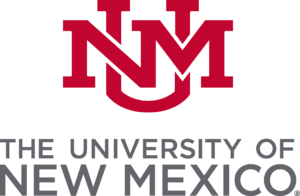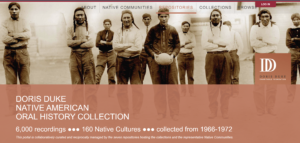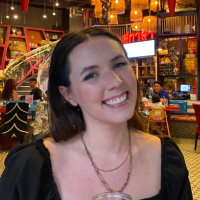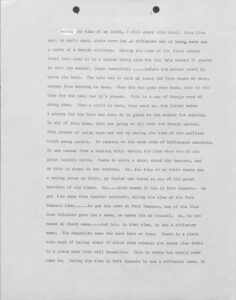Digitized Oral History Puts Control Back in the Hands of Native Communities

The University of New Mexico (UNM) has been one of seven universities working on a collaborative project to create and preserve oral history recordings and transcripts of 160 Native cultures as a part of the Doris Duke Native Oral History Revitalization Project. The project, which started with original recordings in 1966, is now being made digitally accessible to promote accessibility and utility to Native communities and the public.
About the Doris Duke Native American Oral History Revitalization Project
Born in 1912, Doris Duke was the heiress to the American Tobacco Company and Duke Energy Company fortunes. Duke used her large inheritance to travel the world, pursue her interests and contribute to many causes through her Doris Duke Charitable Foundation (DDCF) which aimed to “improve the quality of people’s lives through grants supporting the performing arts, wildlife conservation, medical research and child well-being.”
In 1966, the foundation initiated the original project which recruited seven universities across the United States – including the University of New Mexico – to visit reservation communities and record Native spoken histories. Each university would act as the repository for their own holdings, all of which were recorded between 1966 and 1972.
Recognizing the value of these collections, the DDCF has recently provided grant funding to each of the original universities to digitize their respective portion of the recordings and transcripts for online access. The Association of Tribal Archives, Libraries and Museums (ATALM) was also given a grant to coordinate the effort between the universities and create the website that will hold the digital archives.
University of New Mexico’s Collection
Twenty-five tribes are included in UNM’s recordings, including a significant number of recordings from the Navajo tribe. Other tribes represented include the Isleta, Zuni, San Jose, Koyukon and Nunamiut. Some recordings reach outside the four corners to California, Alaska and Washington.
Using typewriters, the resulting 900 interviews conducted by UNM were transcribed onto over 15,000 pages of paper. The pages were also written onto microfilm for a long-lasting storage copy.
When the UNM’s Center for Southwest Research and Special Collections was established in 1980, the collection was transferred to their holdings. Over the years, researchers could access the collection on-site at the Center and pages were sporadically scanned as off-site researchers requested.
Digitize to Revitalize
Rachel Sullivan had just completed her Master of Library and Information Science practicum at UNM on this collection before she was hired on as the project archivist for the revitalization. The project was split into two parts: the scanning of the paper transcripts and digitization of the audio files.
Since not all transcripts had been previously scanned and the microfilm copy was in poor condition, Sullivan and the UNM team elected to scan the original typewritten transcripts. The original pages were in good but delicate condition due to age and use so gentle capture was a key consideration. In early 2021, the DDCF grant funds were used to purchase a Zeutschel OS 15000 Overhead Book Scanner specifically for its ability to safely capture fragile media.
Sullivan was the primary scanner operator for the project and captured all pages in a six-month period. “During training, the Crowley technician was helpful in teaching us how to use the scanner to produce the best images while still being efficient,” Sullivan states. “We set-up scanning profiles specifically for this job so that we wouldn’t have to worry about re-creating our capture settings every day. After that was in place, the scanning went smoothly and was so fast.” Zeutschel’s versatile OmniScan Software is used across their entire scanner line, lessening the learning curve if UNM ever finds a need for additional book scanners.

The final images are output in two formats: one with Optical Character Recognition (OCR) text-searchability and the other without. Sullivan relayed that many reservations have poor internet connections so adding images with OCR text-searchability to the collection might would slow down the research time significantly in those areas. The OCR image file will be saved digitally at UNM as a copy.
Now that the paper files are captured, the audio files will be digitized. Each audio file, corresponding transcript images and metadata that describes both will then be bundled together to create a “digital heritage item.” The digital heritage items will be uploaded to the ATALM collection website as they are created so users can find all information in one place.
A Story to Tell, A Story to Keep…
A major part of this project, Sullivan advises, is to return “positive control” to the indigenous communities that own these stories.
“When these recordings were originally made, the information gatherers weren’t always transparent about how items would be utilized and there is no paper trail to document consent of the speakers. Part of this revitalization effort is to respectfully navigate that fact while giving control back to the originating communities rather than the repositories.”
She continues, “Some recorded information is culturally sensitive and not for public consumption. With this revitalization effort, the power is put back in the hands of the Native communities to dictate who can access what. Stories or songs that are only meant for tribal elders will have controlled access. Other recordings should only be listened to at certain times of year so they will be made seasonally available. Information on daily life will be accessible to the public.”
Creating a good relationship with the current Native community leaders is a crucial step in this process. Sullivan clarifies, “We are trying to create reciprocal relationships with the originating communities. This means that we need to find an individual who has the interest, time and authority to go through the tapes and transcripts associated with their tribe. Once someone is found by the tribe and the university for a particular community, that person will be given the necessary website access to sort out their cultural heritage items.”
Sullivan notes, “Beyond the professional challenges and rewards of this being my first large-scale project, navigating the cultural aspects of the collection has been a profound experience. These interviews shed light on issues that are still impacting these Native communities and some that have, thankfully, seen an improvement since the recordings were taken.”
…And Stories Yet to Be Told
While there are many steps yet to be taken in improving the damage inflicted on Native American communities, digitizing these cultural heritage materials is a step in the right direction in preserving Native history.
The ATALM is a great resource for finding projects, initiatives and services that benefit indigenous cultural institutions. One such initiative is to improve digital inclusion and broadband infrastructures in Native communities which could allow researchers to use text-searchable archives in the future among many other benefits.
For a list of other initiatives being taken to improve Native American visit the association’s website.
Make an Impact with Your Collection
Digitization can provide a great reach for important cultural heritage collections while creating a reliable copy of valuable materials. Crowley’s specialized hardware selection and knowledgeable imaging experts can support your digitization efforts for any still media type. Call (240) 215-0224 for more information on scanning hardware or to speak with a member of our team.


